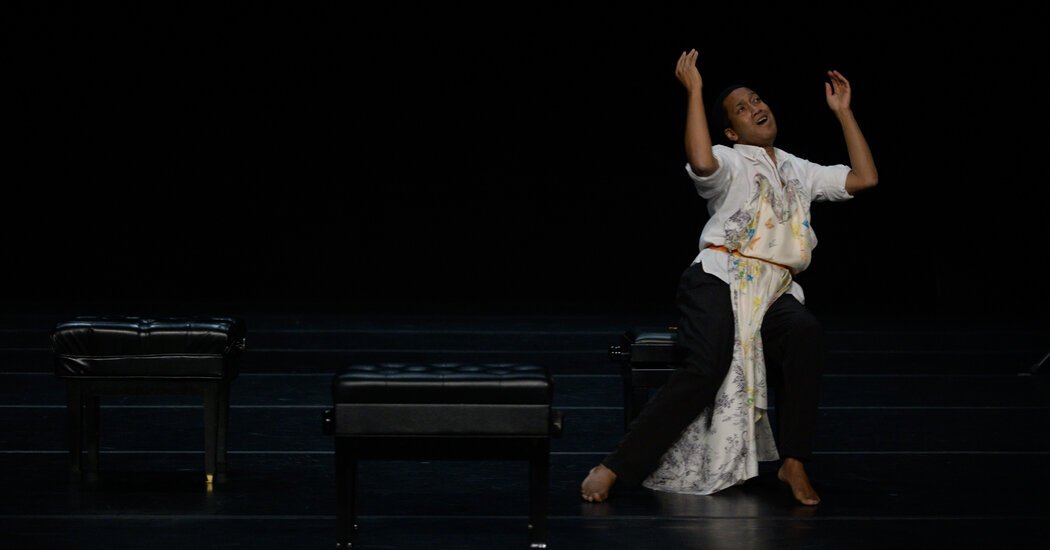[ad_1]
In 1975, the American jazz pianist Keith Jarrett played a solo concert in Cologne, Germany, improvising without a preset structure. The recording of that performance, “The Köln Concert,” became one of the best-selling solo jazz albums ever, its one-man-jam-band free exploration of sounds that you might associate with Rachmaninoff, gospel and country-folk proving as popular with fans of the Grateful Dead as with jazz aficionados.
One can imagine the album’s appeal for Trajal Harrell, an American choreographer who has found his greatest success in Europe. Since 2019, Harrell has been the in-house director of Schauspielhaus Zürich, leading his own dance ensemble. The sound of an adoring European audience, as can be heard on Jarrett’s recording, must be familiar to him.
But Harrell’s “The Köln Concert,” which had its New York debut at the Brooklyn Academy of Music on Thursday, doesn’t start with Jarrett. It starts with Harrell, already onstage as the audience is filing in. Over a shirt and slacks, he wears a dress like a smock. He stands and gazes at his audience as if he were a modern-day royal, trying to look casual while holding court.
And when the music kicks in, it isn’t Jarrett but Joni Mitchell. To “My Old Man,” Harrell starts swaying, swooping, swatting the air, his fingers quivering when Mitchell sings of the lonesome blues. It resembles dance karaoke, or someone dancing alone in a bedroom, except for Harrell’s trademark facial expressions, like Joan Crawford in pain. The vulnerability is armored in affectation.
As more Mitchell songs play, mostly from the album “Blue,” other dancers join Harrell. Sitting on piano benches, they pick up the swaying motion, their arms scooping back and forth as if through water to Mitchell’s “River.” This culminates in “Both Sides Now” — the 2000 version, with a gravelly-voiced Mitchell over strings — and another Harrell trademark: a fashion show, with the dancers taking turns doing runway walks in various outré outfits. They do this very well.
Finally, the Jarrett recording begins (we never hear the whole thing), and everyone comes back in black sleeveless dresses for a succession of solos. These also have an alone-in-the-bedroom feel, as if an elegant woman, a little tipsy and self-pitying, had put the Jarrett on for some sashaying with stumbles. It’s a dance-like-nobody’s-watching style, except that these performers are intensely aware of being watched.
Some of the trouble here is structural. Made in 2021, Harrell’s dance is clearly a pandemic product, with its carefully spaced benches and solo after solo. The solos have a little variation to distinguish them: Titilayo Adebayo swings her long braids like helicopter blades; the statuesque Thibault Lac, a longtime Harrell collaborator, responds to Jarrett’s rapid runs with jerky instability. But they’re all too close to Harrell copies, and the repetition is deadening.
The deeper problem, though, is the near total lack of spontaneity. Much of the joy in the Jarrett recording arises from not knowing where he’s going next and being surprised at how he gets there. In Harrell’s “Köln Concert,” there is no surprise.
Where Jarrett sometimes sits in a groove, his left hand repeating a simple figure as his right hand roams freely, the combination building momentum, Harrell just seems stuck in his routine. He is good at conceptual pairings — his breakout pieces combined vogueing with 1960s postmodern dance — and his coupling of Mitchell and Jarrett helps us hear an affinity between them, a 1970s sound. But Harrell’s “Köln Concert” isn’t really about those artists or the music of its title. It’s about his identification with both. Mostly, it’s about himself.
Trajal Harrell
Through Saturday at the Brooklyn Academy of Music; bam.org.
[ad_2]
